|
|
| LO-FI
TOY KEYBOARD WITH MANY GREAT DISTORTED CHORUS SOUNDS |
|
 |
|
|
|
|
|
|
This noble looking design object is likely the world only keyboard which
right case half can be flipped back for 2 player music play and audiogames.
Although the timbre has similarities with My
Music Center, in detail the sounds are quite unique. They all are
strongly distorted with cold chorus and grainy zipper noise, but this thing
rocks! Jimmy Hendrix likely would have loved it. There are 128(!) sound
variations but unfortunately the preset sounds are transposed to different
notes and a polyphony bug skips notes during fast polyphonic play. But
it is still definitely a great lo-fi sound source that with some presets
even can sound like a trashy old analogue synth.
Unlike My Music Center the instrument is 7 note polyphonic, the
waveforms are more natural (e.g. sonorous pipe organ bass), the bass range
is warmer, envelopes are more variable and each of the 32 preset sounds
can be changed with the "tone effect" button into 4 envelope variants.
The sounds have strong analogue distortion and by this the pulsing tremolo
of the chorus effect warbles duller and brighter in a unique way. Bright
sounds resemble a sitar or my Nigam
- Bulbul Tarang, but there are also many nice, almost analogue
sounding dreamy synth brass timbres with warm distortion. In flipped state
each keyboard half can be set to a different preset sound, and there are
4 audiogames. The instrument has also 5 drumpad and 4 effect pad buttons
with spring noises and SF space laser stuff. But like with
Kawasaki
Pro37 the so-called rhythms are only loop samples those here include
beside drum loops (usable for tekkno) also funk, rock, heavy metal and
hiphop accompaniments; the tempo control simply pitches them up and down
(like changing the speed of a phono record). Unfortunately the user interface
has some flaws, fast polyphonic play often skips notes, and the preset
sounds are tuned differently, which is very confusing (but can be compensated
after adding a pitch control potentiometer). Annoying is also that the
volume of the harsh and thin sounding speaker can not be set lower than
medium ambient volume. But despite all annoying flaws this is a great and
unique sounding instrument.
caution: Before flipping the right
case half you must press the black keyboard release button below the speaker
to unlock the mechanism. The plastic latch inside is far too flimsy and
otherwise will crack off when not properly unlocked.
Someone e-mailed me that in USA this keyboard was also released by DSI
with (counterfeit?) "Yamaha" logo (green case, yellow speaker, strange
license sticker from Yamaha Motorcycles (not musical instruments!)
on the back), and that also a light blue version came out (possibly released
by Oregon Scientific). Another one was released as Kawasaki -
Dual Cool Key (green frame, violet panel, yellow speaker). Also a blue
with clear white version was made (both seen on eBay).
main features:
-
48 midsize keys (especially sharps need a bit much force, flippable into
2x 24 keys)
-
built-in small speaker (sounds very thin, harsh and distorted)
-
main voice polyphony 7 notes (but a polyphony bug truncates held notes
during fast play)
-
32 preset sounds divided into 4 groups with each 8 sounds:
-
{grand piano, trumpet, pipe organ, tuba, violin, saxophone2, elec. guitar}
-
{music box, flute, church organ, strings, saxophone, banjo, hammond organ,
harmonica}
-
{jazz guitar, honky tonk, brass, cello, english horn, clarinet, harpsichord,
horn}
-
{oboe, accordion, harp, alto sax, strings 2, mandolin, xylophone, percussive
organ}
(cycled through by each a single button)
-
10 preset "rhythms" divided into 2 groups with each 5 sounds (those are
genuinely drum- & accompaniment loop samples)
-
volume +/- buttons (6 steps)
-
tempo +/- buttons (5 steps, changes pitch of "rhythm" sample loops only
after the loop point)
-
"tone effect" button {normal, clang echo, howl down, delay} (envelope variants
of the preset sounds)
-
keysplit mode in flipped state (flipping by 12° is enough)
-
5 drumpad buttons {"drum 1".."drum 5"} = {gong, closed hihat, low tom,
base, high tom}
-
4 effect pad buttons {"1".."4"} = {sproing up, spring boing, zap boom,
space riochet}
-
The 8 channel sound generator synthesizes each main voice sound by layering
2 waveform samples those have a digitally switched volume envelope (with
well audible ticking zipper noise). The envelopes stop too soon and
thus don't sound realistic. The waveforms on both channels are detuned
to create a chorus effect. Percussion/ effect sounds employ unlooped samples.
All samples have low resolution and there is some DAC aliasing noise in
high notes.
-
CPU= "D..W, Z0944AA7101" + separate ROM(?)= "44AA, 7102(?)" (both COB)
-
simple sequencer (monophonic record & playback of 32 notes or drum
pad events, no edit, quite useless because contents is erased as soon anything
else but "play", drumpads or "tone edit" is pressed).
-
4 audiogames for 2 player play training
-
auto power- off
modifications:
-
speaker rim sealed with foam rubber strip for more bass.
notes:
The operating concept of this instrument resembles Casio
SA-35 or Yamaha PSS-7; the
preset sounds are selected through group buttons those each cycle through
multiple sounds. The selected sound is played during button press, and
without rhythm most other buttons play a base drum noise, which disturbs
live performance. 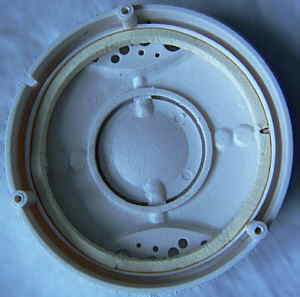 The
user interface also has other flaws; e.g. the stop button always resets
the volume to medium, and the tempo control only takes effect after the
accompaniment sample passes its loop point, which usually causes a delay
of multiple seconds. Other Potex instruments could control their
sample playback speed perfectly (the great Beat
Square - Mix Evolution even backwards). In unmodified state the
speaker sounded extremely thin and harsh, which made the bass part of the
accompaniments almost inaudible. Gluing a thin adhesive foam rubber strip
(window insulation foam) inside the rim of the white speaker cover fixes
this and makes the sound quality at least fairly ok. On the case bottom
is a "demo" switch, which switches the auto power- off time between short
and long. (I haven't analyzed the hardware further yet.) The
user interface also has other flaws; e.g. the stop button always resets
the volume to medium, and the tempo control only takes effect after the
accompaniment sample passes its loop point, which usually causes a delay
of multiple seconds. Other Potex instruments could control their
sample playback speed perfectly (the great Beat
Square - Mix Evolution even backwards). In unmodified state the
speaker sounded extremely thin and harsh, which made the bass part of the
accompaniments almost inaudible. Gluing a thin adhesive foam rubber strip
(window insulation foam) inside the rim of the white speaker cover fixes
this and makes the sound quality at least fairly ok. On the case bottom
is a "demo" switch, which switches the auto power- off time between short
and long. (I haven't analyzed the hardware further yet.) |
The sound programmer must have been on drugs or dyslexic, since many
presets sound not remotely like what their name suggests, and very annoying
is that many preset sounds are tuned to wrong notes (mentioned below).
Also the strong chorus effect makes most sounds unrealistic. Like with
My
Music Center the preset sounds are not realistic but have a synthetic
cold chorus timbre with zipper noise and some DAC aliasing noise in high
notes. But unlike the latter, here the timbres are more natural and contain
analogue distortion that makes them sound more vivid and also the bass
range of some sounds is warmer. (Empty batteries increase the distortion.)
Also the envelopes sound more variable here and like with Feng
Yuan 28061 the chorus tremolo speed varies with the note pitch
(the higher the faster). Flipping the right case half (by 12° is enough)
switches the instrument into keysplit mode; now the preset sound group
buttons 1 and 2 control the left half while 3 and 4 control the right half
(thus each half has only 16 preset sounds available). In this mode an annoying
polyphony bug in each half randomly truncates its notes when more than
2 keys are pressed.
The "piano" resembles the My Music Center one but is less detuned
and held notes decay slower. Also "trumpet" (tuned to D) resembles the
My
Music Center one, although this one is less harsh and can not reach
that high notes; the bass range is buzzy and disharmonic. "pipe organ"
(tuned to G) is a halfway realistic metal pipe organ rank with sonorous
bass range. "tuba" has too slow attack, sustain and a dull synth brass
timbre with mids resembling a french horn; high notes rather resemble a
metal flute. "violin" (tuned to D) sounds like on My Music Center;
"saxophone 2" resembles "violin" with a more brassy waveform; the slow
attack is very unrealistic and it sounds more like synth strings. "bell"
has sustain and doesn't decay (not realistic); it rather resembles a bowed
glass, although with high notes the chorus tremolo is too fast. "elec.
guitar" sounds like a semi- hollow acoustic guitar with quite fast decay;
longer key press makes note shorter. "music box" (tuned to D) resembles
a glass celesta, but the bass range sounds dull like an acoustic guitar.
"flute" resembles a metal flute with slow attack and dull bass range. "church
organ" is a slightly brighter variant of it and with 1 second long sustain.
"strings" (tuned to D) resembles a cello in the bass range; high notes
resemble a pipe organ. "saxophone" (tuned to D) sounds in the mids halfway
realistic; the bass range grunts buzzy and a bit disharmonic. "banjo" sounds
halfway realistic. "hammond organ" is not realistic at all but resembles
a metal pipe organ rank with slow attack and 1 second sustain. "harmonica"
has the same envelope with a duller semi- brassy waveform that in the mids
resembles a french horn. "jazz guitar" resembles a slightly thin harp.
"honky-tonk" is no piano at all but is a dull synth string or reedy clarinet
timbre with slow attack. "brass" (tuned to D) is also wrong; it resembles
a reed organ timbre with very sonorous, warm and buzzy bass range and loud
sustain that suddenly stops after 1 second. "cello" (tuned to G#) has the
same envelope with semi- brassy string timbre (resembling a french horn).
Also "english horn" (tuned to D) has the same envelope with a thin waveform
resembling an oboe or harmonica. "clarinet" (tuned to G) is another hollow
synth brass timbre with sustain. "harpsichord" is the same in slightly
brighter. "horn" has the "brass" waveform with another french horn timbre.
"oboe" (tuned to G) is a harsh brass timbre with slow attack and sustain.
"accordion" (tuned to D) is too hollow to sound realistic. "harp" sounds
ok (envelope like "jazz guitar"). "alto sax" (tuned to D) has slow attack
and rather a harsh strings timbre; only medium high notes are halfway realistic.
"strings 2" (tuned to D) is another pipe organ rank with warm bass range,
slow attack and 1 second sustain. The "mandolin" rings with 8Hz. "xylophone"
(tuned to B) sounds only in the mids remotely realistic; the bass range
resembles rather a fast decaying e-bass. The "percussive organ" is not
percussive at all, but yet another synth strings timbre with slow attack
and 1 second sustain.
The "tone effect" button cycles each sound through 3 additional envelope
variants. Variant 1 modulates the volume envelope with a kind of bell clang
texture that turns faster and slow again and then stops; it truncates the
now always held notes after 1 second and sounds very unique. Variant 2
sounds like the original but the pitch slightly howls down during attack
and howls up again after key release; the effect is quite gentle and mostly
audible in the bass range. Variant 3 delays the chorus subvoice of the
preset sound by half a second, which with percussive sounds like a simple
echo and with sustaining sounds gently changes the attack timbre.
The drumpad buttons are numbered "drum 1" to "drum 5" and play the samples
{gong, closed hihat, low tom, base, high tom}. The gong is a 1 second long
Chinese gong. The base may be also a muted tom. Also the 4 effect pad buttons
are only numbered. "1" is a scratchy up howling sort of spring noise. "2"
is a spring boing noise. "3" is a high laser zap quickly followed by a
synth tom. "4" resembles a shot riochet noise that howls up and resembles
an SF space laser sound. When the case is not flipped, the 4 audiogame
buttons play a 5th effect sample, which is another spring boing noise layered
with a howling sheet metal rattle (like the ghost noise from very old horror
movies). The monophonic record/ playback sequencer behaves like with My
Music Center, but drumpads can not be recorded. Strange is that
during playback the only still active buttons are "tone effect" and the
5 drumpads, but not the effect pads.
The 10 preset "rhythms" are drum loops and accompaniments (of little
use for melody play) those are simply loop samples of fixed- key, thus
the tempo control also changes their pitch by simply changing the sample
playback frequency. A confusing flaw is that tempo control only takes effect
after the accompaniment sample passes its loop point, which can take a
few seconds.
The accompaniment patterns are:
-
fusion accompaniment (with trumpet)
-
rock rhythm (base + distorted snare)
-
tekkno rhythm (distorted base, kind of train noise)
-
hiphop rhythm (drum kit with odd metallic buzz)
-
funk accompaniment (wokachika e-guitar, e-bass)
-
hard rock accompaniment (e-guitar, drum kit)
-
fusion accompaniment (with tuba, e-guitar, boom noise)
-
house rhythm (?, distorted base with handclap)
-
slow heavy metal accompaniment (distorted e-guitar, drum kit)
-
funk accompaniment (e-guitar, e-bass)
The 4 audiogames are for 2 players and only work when the case is flipped.
They are selected with the "G1" to "G4" buttons. 2 red LEDs indicate which
player is up.
-
game 1: Keyboard Race
Both players have to press all keys in their half from left to right.
The fastest player wins, which is indicated by his lit player LED and applause.
-
game 2: Memory Game
The first player has to improvise a 15 note sequence. Then the 2nd
player has to repeat that melody. Afterward a base drum sounds; the count
of beats indicates how many notes were played correctly.
-
game 3: Note Finder
A note sounds and both players have to hit the correct key. The fastest
player wins, which is indicated by his flashing player LED and applause.
-
game 4: Dueling Notes
A randomly selected preset rhythm starts. Now each player has to play
notes only when his player LED is lit; when one makes a mistake (plays
with his LED off or stops playing with his LED lit), the other wins, which
is indicated by his flashing player LED and applause.
Other toy keyboards with flippable case halves are the Sound
Mixer HMP-288 and the Super Electronic Keyboard (case details
like Super Jam with more buttons, clear blue with black case, box
shows yellow and silver, seen on eBay). Another My Music Center
variant by Potex with way less flaws is the Cyber
Keyboard and another
My Music Center variant with lots of
sounds (including the Super Jam pipe organ and brass timbres etc.)
is the great Elta- EK-491 (49 midsize
keys with even a simple synthesizer and MIDI out).
| removal
of these screws voids warranty... |
|
|
 |

|
|
| |
back
|
|
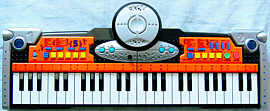
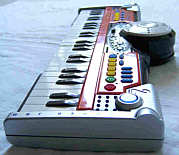
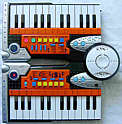
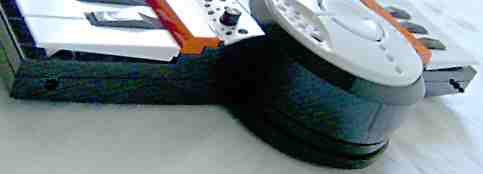




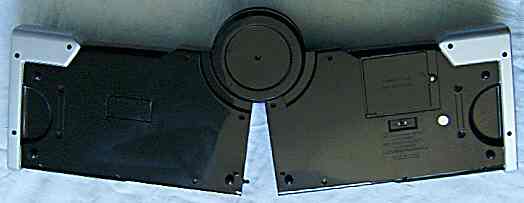
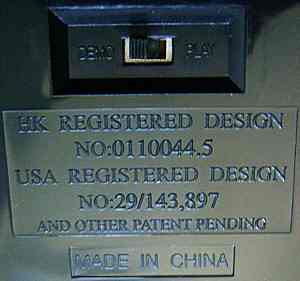
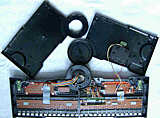

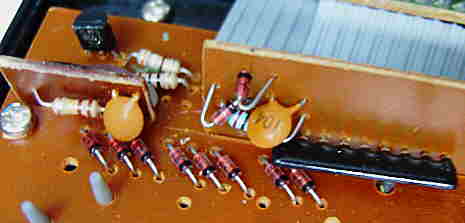
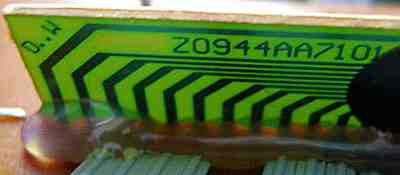
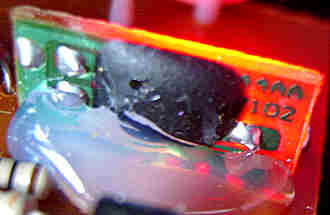
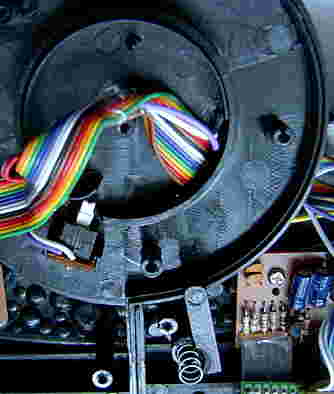
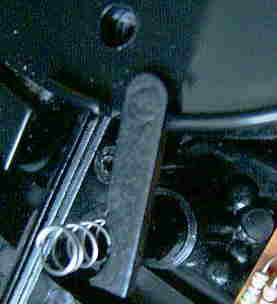

 The
user interface also has other flaws; e.g. the stop button always resets
the volume to medium, and the tempo control only takes effect after the
accompaniment sample passes its loop point, which usually causes a delay
of multiple seconds. Other Potex instruments could control their
sample playback speed perfectly (the great Beat
Square - Mix Evolution even backwards). In unmodified state the
speaker sounded extremely thin and harsh, which made the bass part of the
accompaniments almost inaudible. Gluing a thin adhesive foam rubber strip
(window insulation foam) inside the rim of the white speaker cover fixes
this and makes the sound quality at least fairly ok. On the case bottom
is a "demo" switch, which switches the auto power- off time between short
and long. (I haven't analyzed the hardware further yet.)
The
user interface also has other flaws; e.g. the stop button always resets
the volume to medium, and the tempo control only takes effect after the
accompaniment sample passes its loop point, which usually causes a delay
of multiple seconds. Other Potex instruments could control their
sample playback speed perfectly (the great Beat
Square - Mix Evolution even backwards). In unmodified state the
speaker sounded extremely thin and harsh, which made the bass part of the
accompaniments almost inaudible. Gluing a thin adhesive foam rubber strip
(window insulation foam) inside the rim of the white speaker cover fixes
this and makes the sound quality at least fairly ok. On the case bottom
is a "demo" switch, which switches the auto power- off time between short
and long. (I haven't analyzed the hardware further yet.)